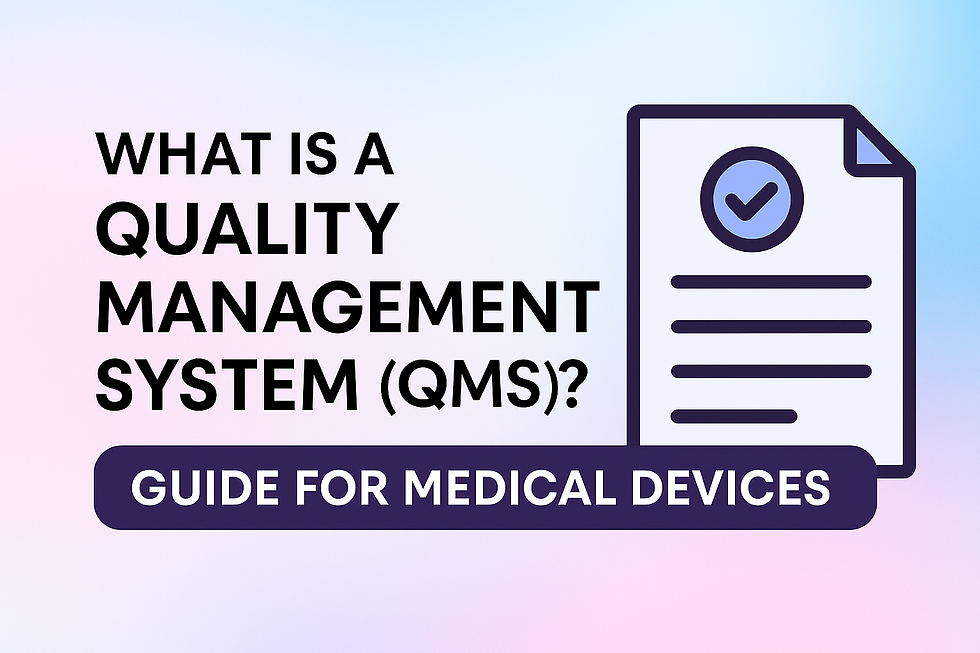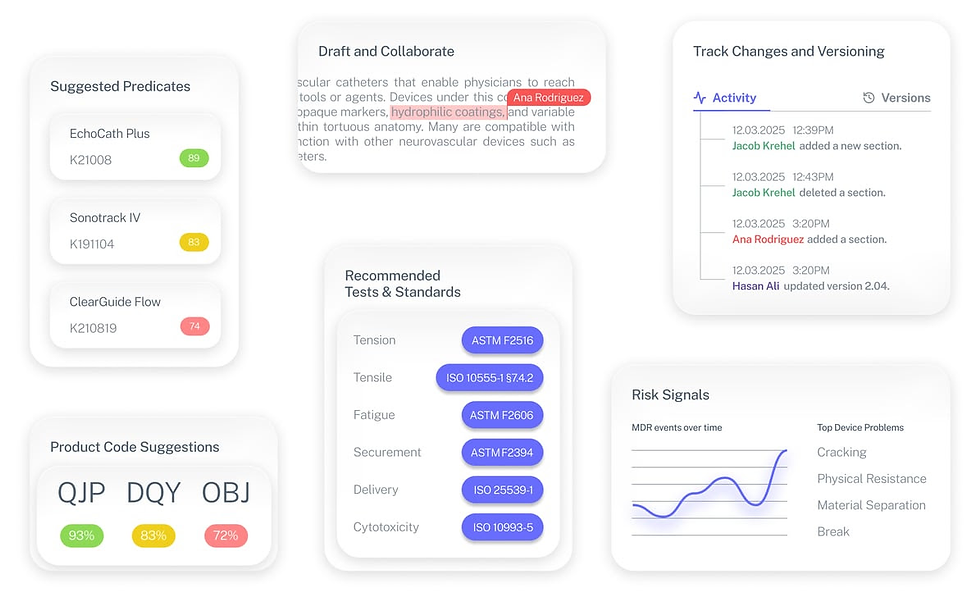Medical Device QMS (2025): ISO 13485 & FDA QMSR 2026 Guide
- Beng Ee Lim

- Aug 7
- 5 min read
Updated: Sep 7
A medical device Quality Management System (QMS) proves you can consistently design, make, and support safe, effective devices. It's required for market approval in virtually every major jurisdiction and serves as your roadmap for avoiding costly mistakes, recalls, and regulatory delays. In the U.S., FDA will replace QSR (21 CFR 820) with QMSR on Feb 2, 2026, incorporating ISO 13485:2016 by reference. Globally, ISO 13485 remains the baseline. FDA does not require ISO 13485 certification, but expects a compliant QMS and will inspect it. This guide breaks it all down.

The 2026 QMSR Game-Changer Every Company Must Know
Critical Alert: On February 2, 2026, medical device manufacturers must fully comply with FDA's revamped regulations at 21 C.F.R. Part 820. The final QMSR rule, issued January 31, 2024, replaces nearly all existing QSR requirements with internationally recognized standard ISO 13485:2016.
This means if you're not already ISO 13485:2016 compliant, time is ticking for you to completely overhaul your quality system. FDA granted a two-year transition—but inspections after Feb 2 2026 will be to QMSR/ISO 13485.
The Bottom Line: Start your QMSR transition immediately or face potential compliance disasters in 2026.
What Makes a QMS Different from General Quality Control?
A medical device QMS goes far beyond basic quality control. In simple terms, a medical device quality management system (QMS) is a structured system of procedures and processes covering all aspects of design, manufacturing, supplier management, risk management, complaint handling, clinical data, storage, distribution, product labeling, and more.
Unlike general quality systems, medical device QMS requirements are:
Legally mandated for device registration
Lifecycle-focused from concept to post-market
Risk-based with formal risk management integration
Audit-ready with extensive documentation requirements
Globally harmonized through ISO 13485:2016
Core QMS Components That Regulators Inspect
1. Design Controls (The Make-or-Break Foundation)
Design controls are crucial for ensuring medical devices meet safety and performance requirements. This includes:
User needs and design inputs
Design outputs and specifications
Design reviews at critical stages
Verification and validation testing
Design transfer procedures
2. Risk Management (Your Regulatory Safety Net)
FDA's expectation for years has been for manufacturers to apply ISO 14971 across the entirety of their quality management systems. Risk management must be integrated throughout your entire QMS, not just during design.
3. Document and Record Control
Every QMS decision must be documented and traceable. You need to create documents and records throughout your medical device product development to demonstrate you have considered the risks and are doing something about it.
4. Supplier Management
Your QMS is only as strong as your weakest supplier. Your suppliers and manufacturers are integral to the long-term success of your growing medical device startup.
5. Corrective and Preventive Actions (CAPA)
Corrective and preventive actions (CAPA) – Identifying and addressing potential product issues before they escalate.
QMS Requirements by Market: The Global Landscape
United States - FDA QSR/QMSR
Current: 21 CFR Part 820 (Quality System Regulation)
Effective Feb 2, 2026: QMSR incorporating ISO 13485:2016
Scope: All Class II/III devices, selected Class I devices
European Union - MDR
Standard: ISO 13485:2016 compliance
Requirement: Notified Body assessment for most devices
Additional: EU MDR-specific requirements overlay
Canada - CMDCAS
Based on: MDSAP
Requirement: Since 2019 Health Canada accepts only an ISO 13485 certificate issued via MDSAP.
Global Markets
Nearly every major market requires the implementation and maintenance of a quality management system as a condition of product registration.
QMS Implementation Strategy for Startups: The Bootstrap Approach
Critical Insight: Medical device startups bootstrap their product development all the time. The approach has merit for developing products. Bootstrapping a medical device quality system makes good sense too. Build your medical device quality system as you need it.
Phase 1: Essential Foundation (Months 1-6)
Focus on these critical procedures first:
Design Controls - Document your development process
Risk Management - Implement ISO 14971 framework
Document Control - Version control and approval workflows
Supplier Management - Basic supplier evaluation procedures
Phase 2: Pre-Production Expansion (Months 7-18)
Management review procedures
Internal audit processes
CAPA system implementation
Manufacturing procedure development
Phase 3: Commercial Readiness (Months 19-24)
Post-market surveillance
Complaint handling procedures
Full supplier management
Complete audit trail documentation
The Hidden Costs of Poor QMS Implementation
Regulatory Disasters Waiting to Happen:
FDA Rejections: Management-review & design-control violations sit in the FDA’s top-10 Form 483 list every single year—172 hits in FY-2023 alone. A weak QMS will almost certainly draw a Form 483.
Design Control Failures: Without keeping systematic records of design controls and changes made to the product, the FDA may challenge information provided during a regulatory submission.
Investor Red Flags: Implementing a right-sized quality management system for startups builds credibility with investors. Between 2002 and 2020, the value of merger and acquisition deals more than doubled, but between 70%-90% failed to deliver expected value.
eQMS vs Paper-Based: Making the Right Choice
For Startups: Start Smart, Not Perfect
A simple cloud-based system with adequate permissions, and a decent way of recording reviews/approvals and signatures is a good start.
When to Consider eQMS:
Document volume exceeds 100+ controlled documents
Multiple team members need simultaneous access
Regulatory submission timeline is aggressive
Investor due diligence is approaching
2026 QMSR Transition Checklist
Immediate Actions:
Gap analysis against ISO 13485:2016
Risk management procedure overhaul
Management responsibility updates
Document control system alignment
Implementation Phase:
Staff training on new requirements
Procedure updates and approvals
Internal audit against QMSR
Corrective action implementation
Final Preparation:
Management review of QMSR compliance
Inspector readiness assessment
Regulatory submission updates
Supplier notification and alignment
Common QMS Mistakes That Kill Medical Device Startups
The "We'll Fix It Later" Trap
Right-size, don’t postpone. Stand-up a minimal e-QMS covering Design Controls, Risk File, and Doc-Control in the first 3-6 months, then layer on CAPA and PMS as you scale.
Over-Engineering Too Early
However, it's important to right-size the quality system. If your project is still in the early phases of design control, you don't really need post-market surveillance or unique device identifier (UDI) processes.
Ignoring Risk Management Integration
Keep a living ISO 14971 risk file. Update FMEA after every design or supplier change and link hazards ⇨ CAPA ⇨ Design-Control evidence. Show auditors continuous risk review in quarterly Management-Review minutes.
Getting Expert Help: When and Why
Before building your QMS, seek advice from a regulatory or quality consultant. These experts can: Help you understand which ISO 13485 and regulatory requirements apply to your product. Identify which procedures you need first and how they should be structured. Ensure that your QMS can scale with your company's size, experience, and culture.
Consider professional help when:
Your device is Class III or high-risk Class II
You're targeting multiple global markets
Your team lacks QMS experience
Investor timeline is aggressive
The Fastest Path to Market
No more guesswork. Move from research to a defendable FDA strategy, faster. Backed by FDA sources. Teams report 12 hours saved weekly.
FDA Product Code Finder, find your code in minutes.
510(k) Predicate Intelligence, see likely predicates with 510(k) links.
Risk and Recalls, scan MAUDE and recall patterns.
FDA Tests and Standards, map required tests from your code.
Regulatory Strategy Workspace, pull it into a defendable plan.
👉 Start free at complizen.ai

Frequently Asked Questions
Q: Do all medical devices need a QMS?
Most do. Most medical devices will require some form of a QMS; the complexity of the QMS will vary based on the classification of the device.
Q: When should startups implement a QMS?
A pre-production QMS is ideal for medical device manufacturers that are 18-24 months away from commercialization and distribution.
Q: What's the difference between QSR and QMSR?
The revised part 820 is now titled the Quality Management System Regulation (QMSR). When referring to the rule that is currently effective, the FDA uses the term "Quality System (QS) Regulation" or "QS regulation".
Q: Can we outsource QMS compliance?
You can get help implementing it, but the responsibility remains yours. The QMS must be integrated into your actual business operations, not just documented procedures.
Ready to build a QMS that accelerates your path to market? Start with design controls and risk management—these form the foundation that regulators scrutinize most closely



